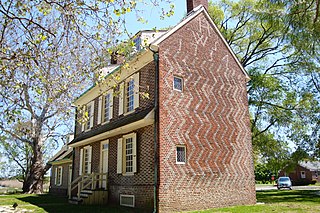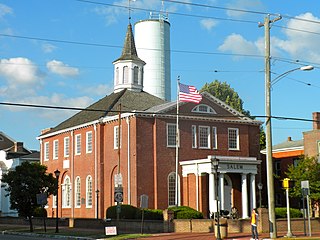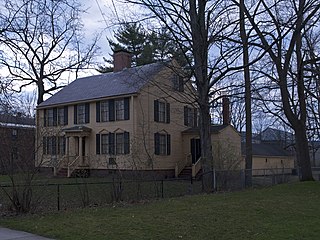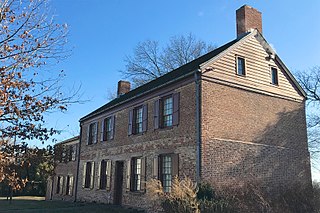
Salem County is the westernmost county in the U.S. state of New Jersey. Its western boundary is formed by the Delaware River, and it has the eastern terminus of the Delaware Memorial Bridge, which connects the county with New Castle, Delaware. Its county seat is Salem. The county is part of the South Jersey region of the state.

The Franklin Inn, also known as the Franklin Inn-Van Liew Homestead, is located at 2371 Amwell Road in East Millstone, New Jersey. The oldest portion of the structure was built as a farmhouse was built by Cornelius Van Liew in 1752. After the American Revolutionary War, the house was known as the Annie Van Liew house, after the daughter of Cornelius who successfully sued the British government for property damage and loss incurred during the war. After the Van Liew family sold the property, the farmhouse was remodeled as a tavern and inn. The Franklin Inn was added to the National Register of Historic Places as a contributing property of the East Millstone Historic District on March 17, 1983.

The Hancock House is a historic structure in the Hancock's Bridge section of Lower Alloways Creek Township, Salem County, New Jersey, United States. It was the site of the 1778 Hancock's Bridge massacre. The site is on the National Register of Historic Places.

The Gabreil Daveis Tavern House, also known as the Hillman Hospital House, is a historic building in the Glendora section of Gloucester Township, Camden County, New Jersey, United States. This tavern was built in 1756 near the Big Timber Creek and housed boatmen who used the creek to ship goods to Philadelphia. It was designated a hospital by George Washington during the Revolutionary War.

The Merchants and Drovers Tavern is located at 1632 Saint Georges Avenue in the city of Rahway in Union County, New Jersey, United States. The historic tavern was added to the National Register of Historic Places on November 21, 1978, for its significance in architecture, commerce, and transportation.

The James and Mary Lawson House is located at 209 North Main Street in Woodstown of Salem County, New Jersey, United States. The house was built in 1869 and was added to the National Register of Historic Places on February 16, 2001, for its significance in architecture.

Joseph Shinn House is located in Woodstown, Salem County, New Jersey. The house was built in 1742 and was added to the National Register of Historic Places on March 7, 1979, for its significance in architecture and politics/government.

The Market Street Historic District is a 166-acre (67 ha) historic district located along Market Street in the downtown area of the city of Salem in Salem County, New Jersey, United States. It was added to the National Register of Historic Places on April 10, 1975, for its significance in architecture, art, commerce, industry, military history, religion, social history, and transportation. The district includes 44 contributing buildings.

Dickinson House is located on Brickyard Road in Alloway Township of Salem County, New Jersey, United States. The house was built in 1754 and was documented by the Historic American Buildings Survey (HABS) in 1939. The house was added to the National Register of Historic Places on February 20, 1975, for its significance in architecture.

The Allen House is located in the borough of Shrewsbury in Monmouth County, New Jersey, United States. The historic house, which would later function as a tavern, was built around 1710 as a second residence for the Stillwell family of New York. Richard, a wealthy merchant, and his wife Mercy had eight children who were brought up primarily in Shrewsbury. By 1754, after Richard and Mercy had died, their heirs sold the property to Josiah Halstead who transformed the home into the Blue Ball Tavern, "the most noted tavern in Shrewsbury." Taverns served as community centers in the 18th century as much as places to drink and eat. The Vestry of Christ Church held meetings there as did the Shrewsbury Library Company and the Monmouth County Circuit Court.

The Seabrook–Wilson House is located at 119 Port Monmouth Road in the Port Monmouth section of Middletown Township in Monmouth County, New Jersey, United States. The house was added to the National Register of Historic Places on October 29, 1974, for its significance in social history and transportation.

The Village Inn, also known as the Davis Tavern, is located at the corner of Water and Main Streets in the borough of Englishtown in Monmouth County, New Jersey. The oldest section of the building dates to 1732. It was documented by the Historic American Buildings Survey in 1936, with addendum in 1984. The tavern was added to the National Register of Historic Places on November 13, 1972, for its significance in architecture and military history.

The Lambertville Historic District is a 198-acre (80 ha) historic district encompassing the community centered around the intersection of Route 29 and Route 179 in the city of Lambertville in Hunterdon County, New Jersey, United States. The district was added to the National Register of Historic Places on June 30, 1983, for its significance in architecture, commerce, industry, and settlement. It includes 680 contributing buildings, and two contributing structures.

Arneytown is an unincorporated community located along Province Line Road on the border of North Hanover Township in Burlington County and Upper Freehold Township in Monmouth County of New Jersey. It is two miles (3.2 km) north of Jacobstown. Province Line Road was on the boundary line between the Provinces of East Jersey and West Jersey. The area was once called Upper Freehold by 18th-century Quaker settlers. With the establishment of the first post office in 1827, it became known as Arneytown.

The Wyman Tavern is a historic house, former tavern, and now a local history museum, at 339 Main Street in Keene, New Hampshire. Built in 1762 by Isaac Wyman, it also served as the muster ground for militia at the outbreak of the American Revolutionary War. In 1968 the property was acquired by a local non-profit, which leases it to the Cheshire County Historical Society for use as a museum. The building was listed on the National Register of Historic Places in 1972.

The Cedar Bridge Tavern is a historic building located in the New Jersey Pine Barrens in Barnegat Township. It was built around 1740 and is believed to be the oldest intact bar in the United States. It is located at the site of the last skirmish of the American Revolutionary War. It is on the National Register of Historic Places.

The Van Veghten House is a historic building in the Finderne section of Bridgewater Township, New Jersey. It was built around 1725 and served as the headquarters of Quartermaster General Nathanael Greene during the second Middlebrook encampment (1778–79) in the American Revolutionary War. The Somerset County Historical Society owns the house and uses it as its headquarters, including a museum and library. The early 18th-century Old York Road passed by here connecting Philadelphia to New York City. The house was added to the National Register of Historic Places on October 10, 1979 and noted as representing "one of the few remaining Raritan River mansions".

The Raven Rock Historic District is a 53-acre (21 ha) historic district located along Daniel Bray Highway and Quarry Road in the hamlet of Raven Rock in Delaware Township in Hunterdon County, New Jersey, United States. It was added to the National Register of Historic Places on November 10, 2015, for its significance in architecture and community development. The district includes 15 contributing buildings, 2 contributing sites and 13 contributing structures.

The Chester House Inn, also known as the Chester Inn and the Brick Tavern, is a historic building at the corner of Main Street and Hillside Road in Chester Borough, Morris County, New Jersey. It was built from 1810 to 1812 by Zephaniah Drake. Known as the Chester House Hotel, it was documented by the Historic American Buildings Survey (HABS) in 1937. The inn was added to the National Register of Historic Places for its significance in architecture, commerce, and education on July 18, 1974.

The John Parker Tavern is a historic building located at 2 Morristown Road in the borough of Bernardsville in Somerset County, New Jersey. Originally known as the Vealtown Tavern, it was frequently used by Continental Army soldiers during the American Revolutionary War. It was added to the National Register of Historic Places on December 14, 1978 for its significance in commerce, military history, and local history.























